Configure your hybrid courses
Teaching a course in hybrid mode – with in-person-plus-remote (IPR) students – is likely new to you. Moreover, in-person interactions this year will noticeably differ from typical semesters as our campus community needs to follow COVID-19 health guidelines such as social distancing and mask-wearing. Classrooms have been set up with these health guidelines in mind, along with a set of technologies in the S3-assigned instructional spaces to support clear communications when teaching in hybrid mode. We acknowledge that all of this is not normal and can feel stressful for instructors and students alike!
Designing your course flexibly and with an emphasis on online
For instructors teaching hybrid courses, it is critical to make flexible plans and to keep remote instruction (including active learning activities outside of class) as a central part of your course design. In addition to helping the students who are participating remotely throughout the semester, keeping the spine of your course online is important for several reasons:
- You may need to shift your in-person class meetings to remote at some point during the semester (e.g., if your classroom/building needs to be temporarily closed for special cleaning, if on-campus activities are reduced, or if government regulations require CMU classes to go fully remote).
- For Fall 2020, all courses will be conducted remotely after Thanksgiving (including the final assessment period), and in Spring 2021, all courses will be conducted remotely for the first week of the semester. So your plans for these time periods must be conducted in remote-only mode.
- Students who get sick and/or need to self-isolate for some period of time during the semester will need to access your course remotely.
Planning the logistics of who attends when
There are different logistical structures for organizing a course that has both in-person and remote students (see here for info on course delivery modes). The following models illustrate a few options for who attends class when. For each, we note when it is most appropriate and comment on its pros and cons. We hope this helps you identify what approach (or variation/combination) best fits your context.
Concurrent In-Person and Remote
In-person and remote students attend class together. The time and duration of class meetings are as originally scheduled and at the same time for all students.
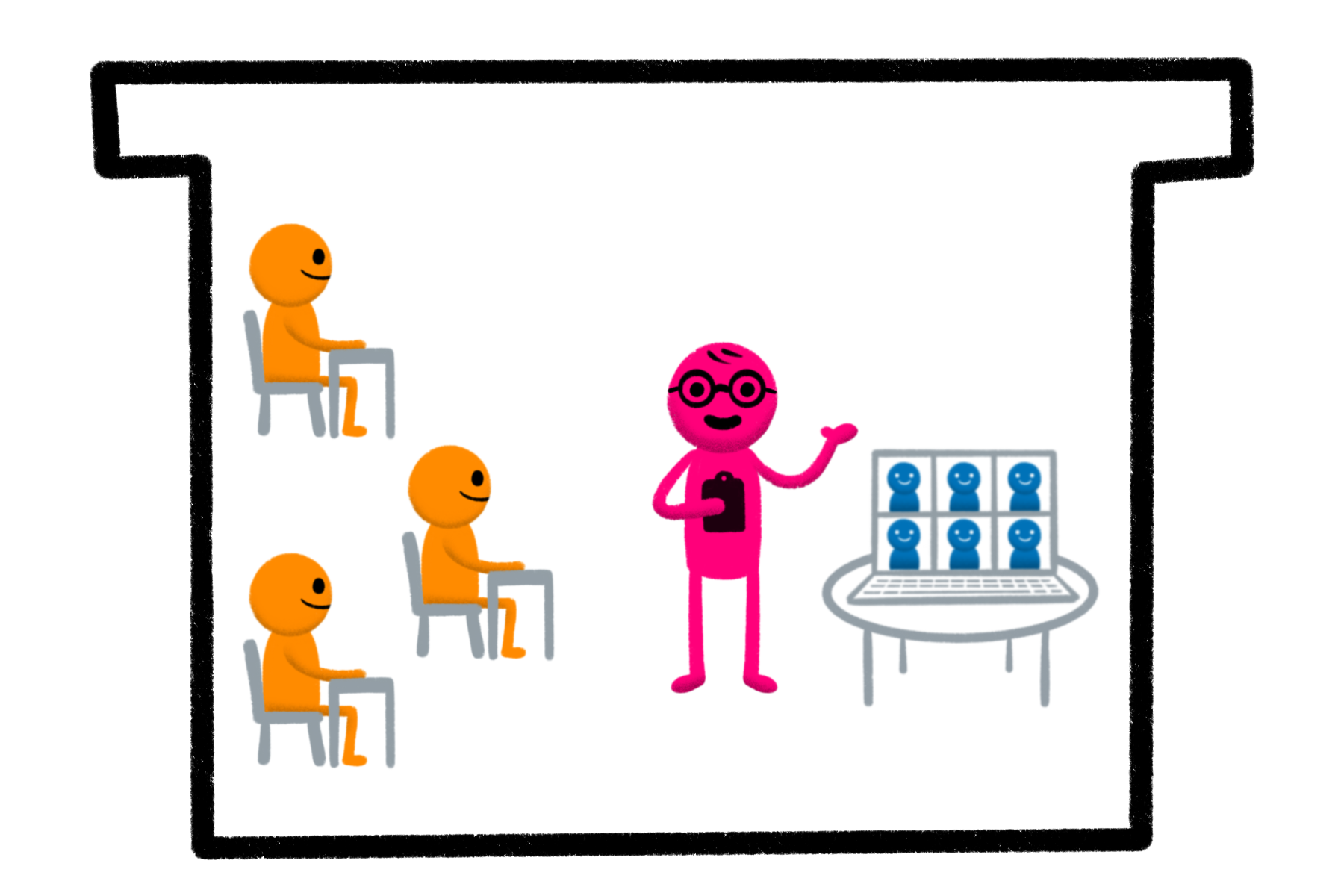
Works well when: students are all in the same (or similar) time zone
Pros: Logistics are most similar to traditional courses
Cons: Instructor needs to attend to both in-person and remote students in class at the same time and make sure both groups stay engaged.
Synchronous + Asynchronous Sessions
For some class meetings, all students attend class synchronously and, for other class meetings, students do asynchronous work (designed to address the corresponding learning objectives).
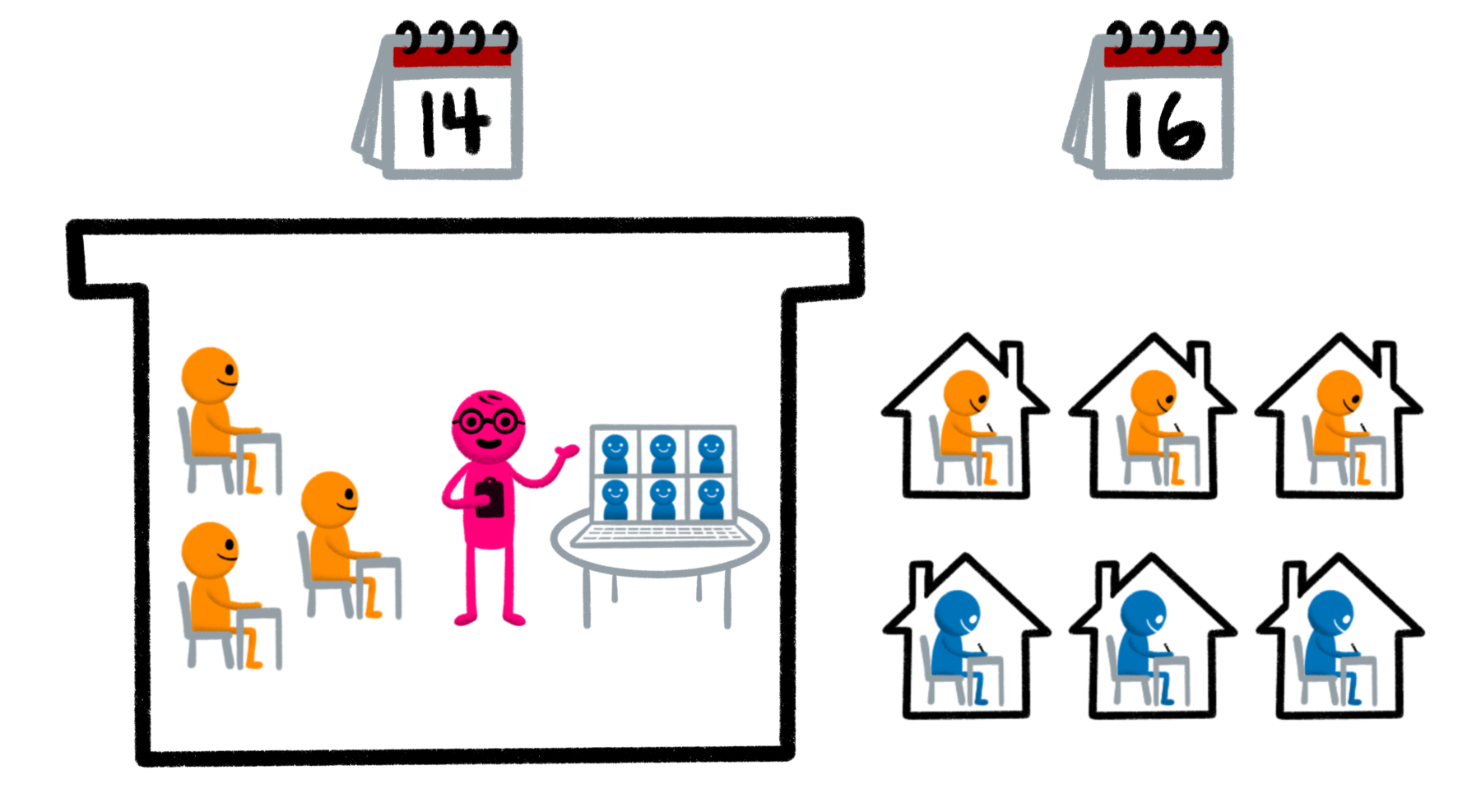
Works well when: Remote students are distributed in many time zones but can manage to attend class at the original timeslot at a reduced frequency. Note: this approach can also be applied to remote-only courses by holding some (remote) class meetings synchronously and assigning asynchronous classwork for others (in lieu of class time).
Pros: The instructor can focus effort on designing and implementing synchronous learning activities for fewer class sessions. Students in distant time zones need not as frequently attend class at challenging times of the day.
Cons: Instructor (and peers) are not present while students are completing asynchronous learning activities, and students may feel less accountable for asynchronous work. These challenges can be ameliorated by a variety of strategies, such as scheduling office hours at different times of day when students are likely doing asynchronous work or assigning asynchronous activities in which students can build on each others’ contributions and/or the instructor can chime in with feedback (e.g., via discussion board assignments, collaborative annotation of readings, or a deliverable that students must submit to demonstrate what they learned/did).
Double Sessions (AKA In-Person Paired section paired with Remote-Only section)
In-person students attend classes in one section of the course (e.g., original timeslot), and remote students attend their own section (in a different time slot or, if two instructors are available, at the same time as the in-person students). Note: For Spring 2021, instructors may request an In-Person Paired (IPP) course modality for the in-person section of this model. Please discuss with your associate dean for specific requirements and approval. The main requirement is that the in-person students should have ready access to a remote option throughout the semester, in case they get sick or otherwise need to attend remotely (e.g., by shifting to a paired remote section or by attending the in-person section remotely).
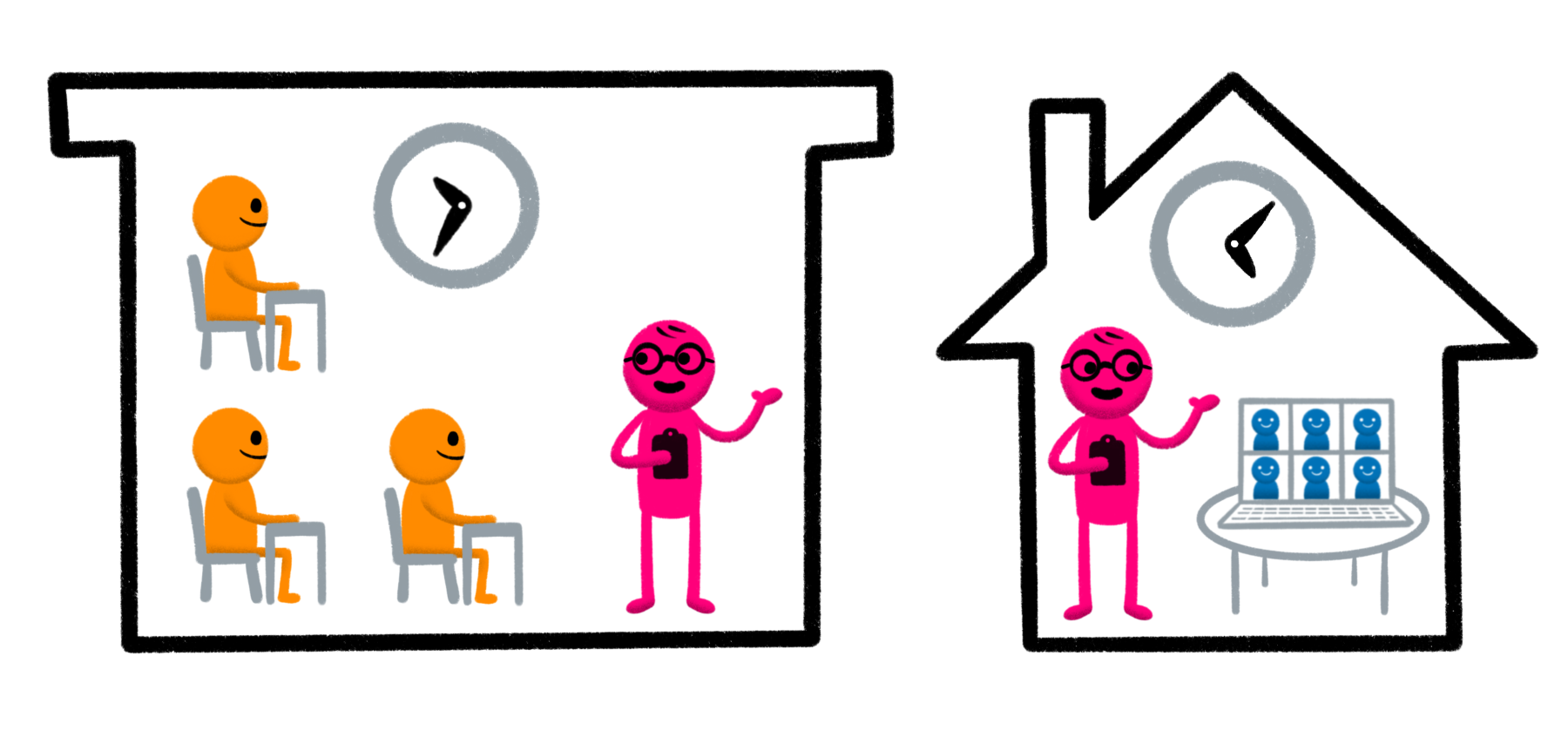
Works well when: Course has multiple sections (e.g., multiple recitation sections) so that two sections can ideally be scheduled at the same time. In any case, the instructor(s) must coordinate across the in-person and remote sections and facilitate students switching to remote if they need to (e.g., they get sick or need to quarantine).
Pros: The instructor need not split attention between in-person and remote students in a given class session, because the two groups of students are enrolled in different sections.
Cons: Instructor effectively teaches two sections of the same course. (Note: If the course already had multiple sections, this model merely re-distributes the teaching load.)
Example [Double Sessions applied to recitations]: Shimpei traditionally teaches a large lecture course MW (100 students) with recitations (approximately 20 students each, once per week). He will conduct the lectures remotely, incorporating active learning strategies to benefit students’ learning and engagement. Shimpei would like to conduct each recitation in a single mode (i.e., in-person OR remote). Because there are already five recitations scheduled and Shimpei has multiple TAs to assist in leading these class sessions, he arranges the recitations so that each can be taught in a single mode: three are taught in person for students who can attend in person, and the other two are taught remotely for the remote students. Note: In addition, he encourages the students within recitations to form study groups, and leverages Piazza for communication among students in the class as a whole.
Alternating Asynchronous
In-person and remote students alternate attending class at the originally scheduled time. When they are not attending class (their “off” day), students engage in assigned asynchronous learning activities. (Note: While the instructor is in class with one group of students, a TA may be assigned to answer questions/provide assistance to the other group of students as they work on the asynchronous learning activities.)
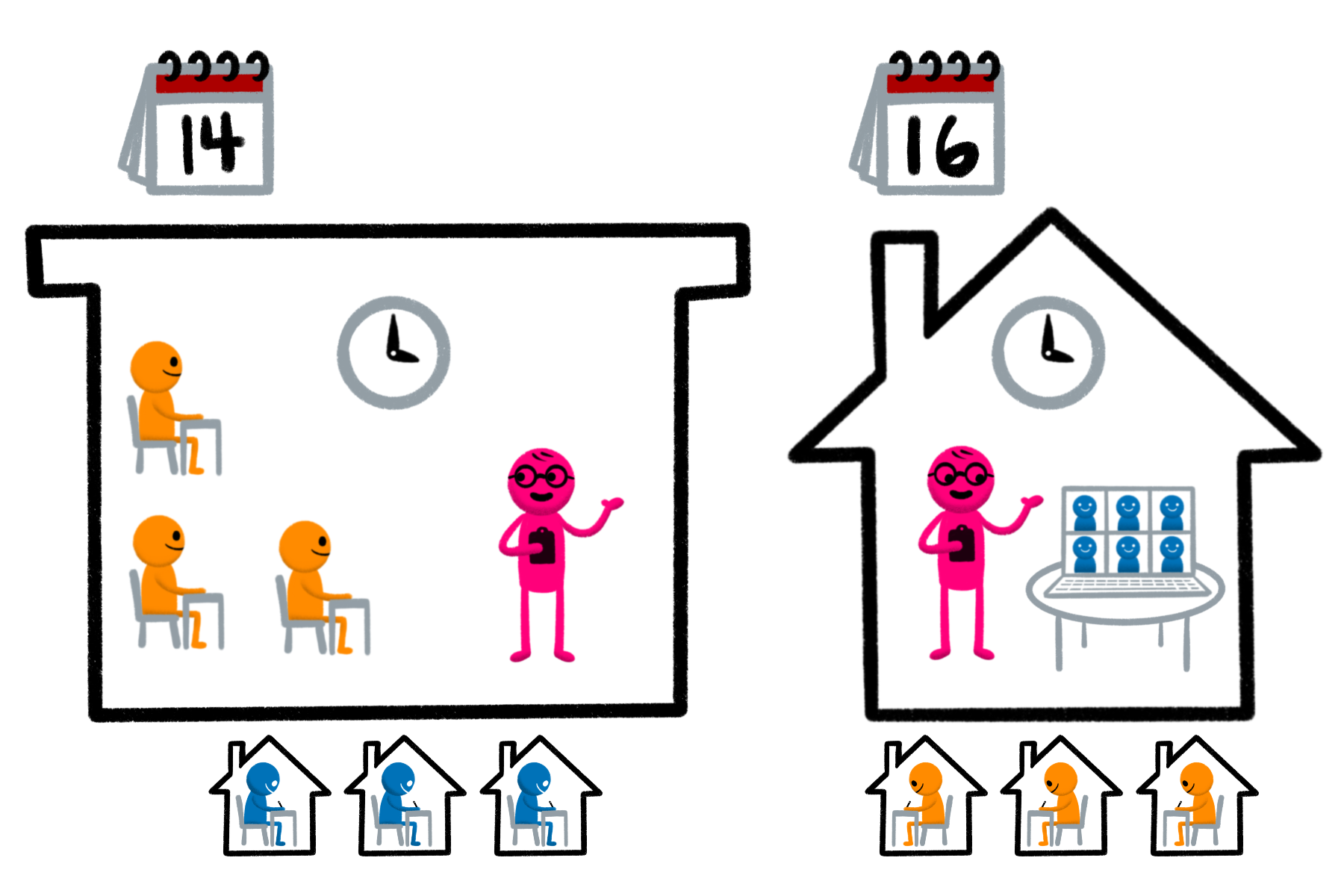
Works well when: students are more distributed across time zones
Pros: The instructor avoids having to split attention between in-person and remote students in a given class session, and does not have to increase teaching time (unlike Double Sessions, where the teaching time is doubled for courses that were originally one section).
Cons: There is some extra overhead to coordinating the schedule and assigning asynchronous learning activities (but asynchronous active learning can be very productive for students).
Example [Alternating Asynchronous]: Jordan is teaching a 9-unit lecture-based class that is scheduled to meet TR for 80 minutes. There are 22 students enrolled, 12 of whom are remote. Jordan already has some instructional videos, course readings, and discussion board activities prepared from Spring 2020, so he decides synchronous class time can be reduced given these outside-of-class learning materials and activities. He uses a flipped class model in which students do preparatory learning outside of class (e.g., watch video snippets and then answer related questions on a Canvas discussion board, complete interactive modules in Canvas or OLI) and then attend class in two shifts: remote students on Tuesdays and in-person students on Thursdays. Class time is used to address students’ questions and for deeper discussion of the material (e.g., case studies, applied problem solving).
Tutorial Model
Students are assigned asynchronous learning activities to complete, and then, interspersed with this asynchronous learning, small groups of students meet with the instructor on a regular basis (e.g., weekly during one of the originally scheduled class times).

Works well when: Class size is moderate or smaller, and/or when seminar-style discussion is the desired pedagogy. Note: This model also may be applied to medium or larger classes by having students rotate into synchronous small groups meetings (i.e., not all students attend the same small group). In this case, it may be possible to schedule in-person students for particular small group meetings and remote students for others, so that the instructor has a single mode of teaching (in-person or remote) for each small group meeting.
Pros: Small-group meetings enable deeper conversations, application of concepts, additional opportunities for student feedback, and closer connections between students and instructors (cf. the “tutorial” model used in many British universities). Students become more self-directed learners.
Cons: Requires shifting a significant portion of the learning to asynchronous activities, which may take additional prep time. May require extra “teaching time” from the instructor, depending on how many groups as well as frequency and duration of small-group meetings.
Intermittent In-Person/Hybrid
Instruction is mostly conducted remotely, but students (both in-person and remote) attend targeted class meetings that are scheduled for specific goals/tasks where whole-class live interaction is especially beneficial. These meetings may be regular (e.g. once every two weeks) or related to a specific event (e.g. a field trip, lab/studio experience).
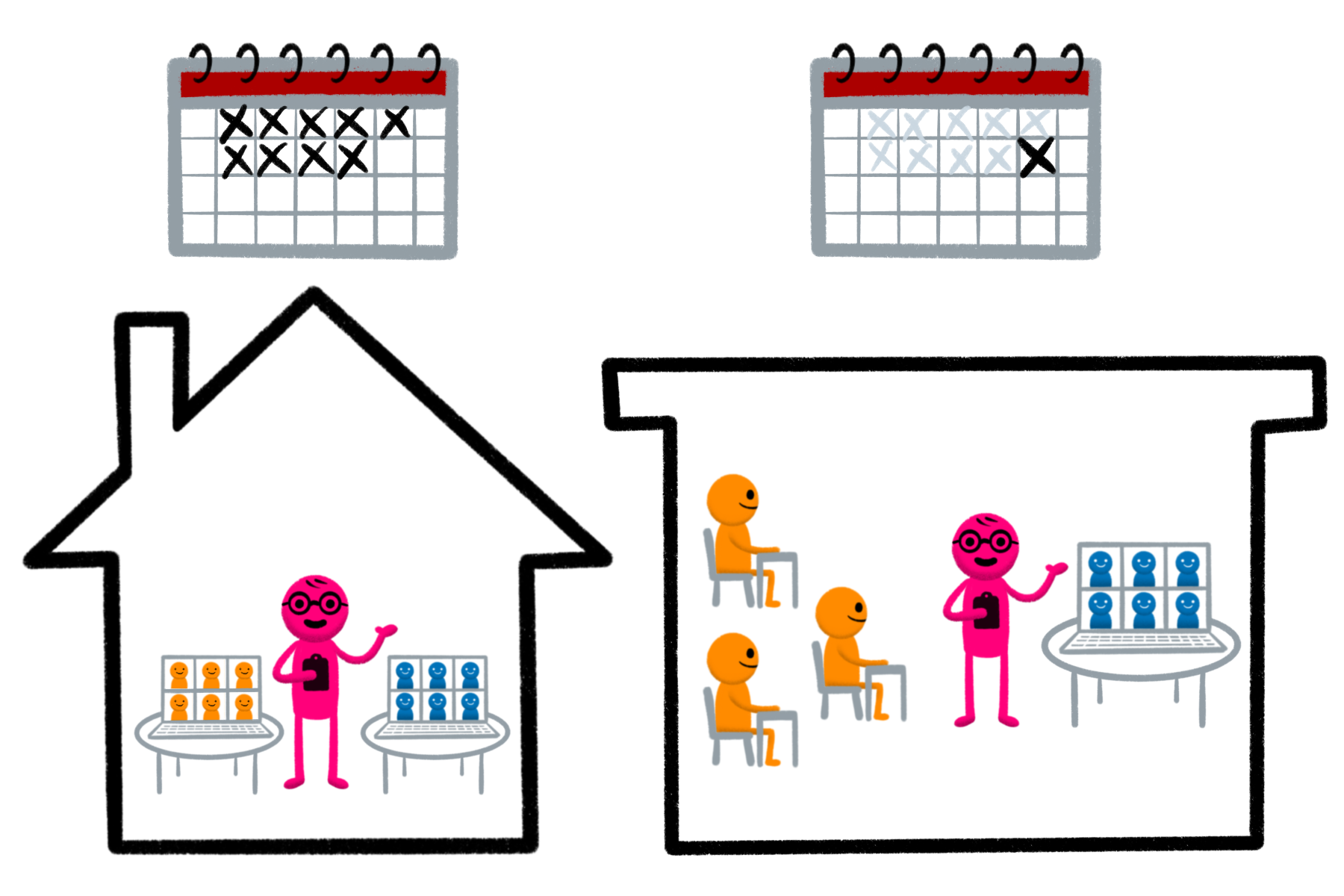
Works well when: remote learning works well in general but targeted experiential, whole-class learning opportunities provide added benefit
Pros: Hybrid class meetings can be planned for specific teaching/learning goals
Cons: Instructor must identify ways for remote students (including those with time zone challenges) to access the experience
Example [Tutorial and Intermittent In-Person/Hybrid]: Neerja is teaching a 9-unit project- and discussion-based class that meets MWF for 50 min. There are 14 students enrolled. Neerja’s students are primarily remote, with only 6 who plan to attend in person. Because her class relies so heavily on discussions and regular small group work, Neerja decides to create small groups of 3-4 students based on their time zones, and she meets with each group weekly during one of the course’s assigned timeslots. (Note: after checking with the remote students, she identifies one group that prefers to meet at a different time to accommodate their time zone differences.) In between these small-group meetings, Neerja keeps the discussion going via Canvas discussion boards, and she keeps tabs on students’ project work via progress reports (submitted online). Neerja also wants students to have the opportunity to share their work and reflections across groups, so she schedules a few class meetings to be attended by the whole class where she has planned a set of activities using a jigsaw approach (i.e., creating impromptu groups that cut across the students “regular” small groups).
As you prepare your course for hybrid or remote instruction, please feel welcome to contact the Eberly Center with questions or to request a consultation. Email: eberly-assist@andrew.cmu.edu. We are here to help!